China is building a ‘city of mirrors’ on the roof of the world.
High on the Tibetan plateau, solar panels stretch across the desert in every direction. They shimmer like a second horizon. Sheep wander between them, grazing on plants that have taken root in the shelter of the glassy rows. Locals call them “photovoltaic sheep.”
The project is billed as the world’s largest solar farm. When finished, it will cover 610 square kilometers — about the size of Chicago — and generate enough power for 5 million households. It’s two-thirds of the way complete, and previous phases are already generating a lot of solar power. And it’s only the latest in China’s relentless sprint to dominate renewable energy.



This has more to do with their goal to cement their control over Tibet than any plan to save the environment.
Of all of the solar capacity China has installed, they actually use only a fraction of it. So it sits dark and good for nothing but being the subject of environmental puff pieces and authoritarian greenwashing. All of their industrialization is at the coast, and it is all powered by coal. Solar is installed in unindustrialized areas, and they haven’t bothered to modify their electricity network to transport the energy to where it would actually reduce carbon emissions.
I think the plan is to use localized inexpensive solar energy to power the industrialization of China’s interior, while continuing to accelerate their use of petrochemicals on the coasts. They’ve built economic protections for their coal industry and are building several more coal fired power plants as we speak. But if the politburo can entice more ethnic Chinese to move to Tibet, then suppressing independence movements will require less government resources. Meanwhile, China’s contribution to the carbon debt will accelerate.